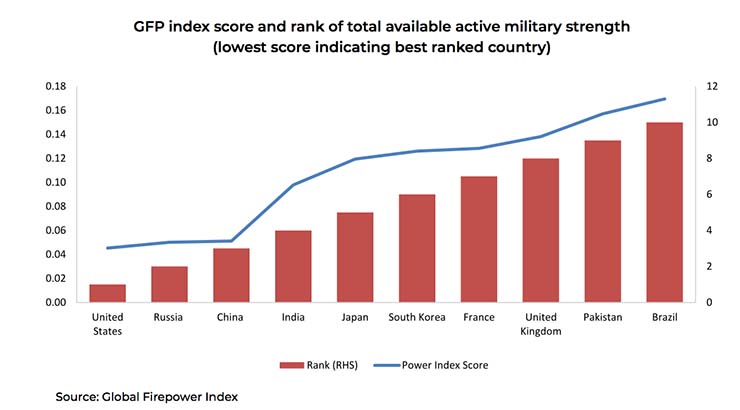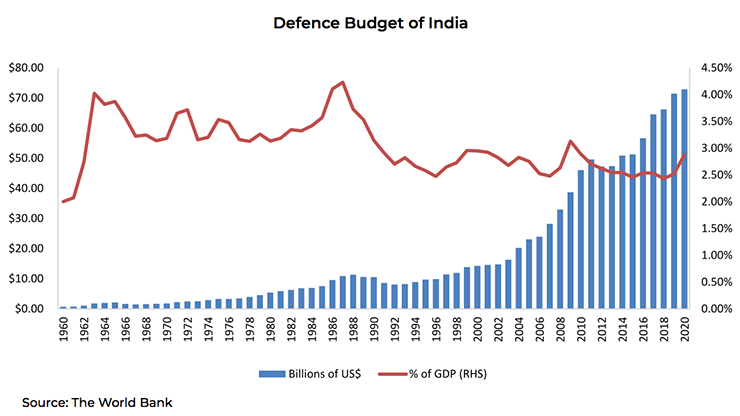India’s defence exports
The Indian armed forces are one of the most powerful forces in the world comprising the Indian Army, Indian Navy and Indian Air Force. The Government of India (GoI) is responsible for safeguarding the defence of India and its borders. The Global Firepower (GFP) annual defence review assigns ranks to different countries on 50 different factors including manpower, airpower, land forces, naval forces, natural resources, logistics, financials and geography. India emerged as the fourth best country in terms of its power index with a score of 0.0979 (0.0000 being perfect) towards the start of 2022.
India has an active military standing at 1.45 lakhs armed personnel. As of January 2022, the country was equipped with 2,182 aircrafts. The country also had approximately 4,614 tanks and 12,000 armoured vehicles. However, India has emerged as one of the largest arms importers in the world, accounting for 11% of the total global arms sales globally.

But India has also realised its need to reduce dependence on defence imports and give more weightage to exports. India was the only country among the top countries of the world, which has significantly diminished its reliance on imports in the past few years. The country witnessed a 21% decline in imports during 2017-21 versus 2012-16. This was due to a growing emphasis on indigenous design and manufacturing of defence equipment by private sector and various state-owned companies.
Increasing defence exports
As per the Ministry of Defence (MoD) statistics, Indian arms exports have seen a six times rise in seven years period from 2014 to 2022, amounting to Rs. 11,607 crore (US$ 1.5 billion) during 2021-22. This astronomical rise was ascribed to various reforms proposed by the government to scale up defence exports and improve the ease of doing business.
The government has set an ambitious export target of Rs. 36,500 crore (US$ 4.8 billion) by 2025. It inked a crucial export deal worth US$ 375 million (Rs. 2,770 crore) with the Philippines for exporting the BRAHMOS supersonic cruise missile in January 2022. India is also in talks with some Middle Eastern countries such as the UAE and Saudi Arabia for exporting the BRAHMOS missile and Akash air defence missiles.
In September 2022, GoI inked a defence pact with Republic of Armenia to export ‘Pinaka’ multi-barrel rocket launcher and other arms and ammunitions worth $40 million or Rs 2,000 crores.
Currently, India exports defence equipment to 75 countries, including Sri Lanka, Russia, Nepal, Mauritius, Israel, Egypt, the UAE, Bhutan, Ethiopia, Saudi Arabia, the Philippines, Maldives, Poland, Italy, France, Spain and Chile.
In 2020, India was the third largest military spending country globally. The country accounted for almost 3.7% of money spent on military in the world. Furthermore, Finance Minister Miss Nirmala Sitharaman in her 2022-23 budget speech spoke about the government’s plan on earmarking 68% of the capital procurement budget for the domestic industry.
Plans to boost exports
Defence Minister Mr Rajnath Singh affirmed the government’s stance on setting aside 25% of the defence R&D budget for private entities and various defence start-ups. ‘Vocal for local’ may push the domestic defence industry and give rise to various innovative start-ups helping in strengthening India’s defence system.
Self-reliance and indigenisation in defence is important for both strategic and economic reasons and has, therefore, been an important guiding principle for the government. Government considers that the industrial and technological development in the sector have made it possible to achieve this objective by harnessing potential of Indian industry along with the technological capabilities developed by academic and research institutions.

Though India has made rapid strides in defence technology and industrial base in recent past, it is yet to cover a significant ground in terms of new products development and scale of production. The domestic defence industry would have limited scope for investment in R&D and production if it relies only on the domestic demand.
There is a need to promote investment in the defence sector, both in R&D and production, thereby resulting in higher self-reliance and indigenisation. While putting in place the policy framework and procedural mechanisms, the thrust should be on indigenous production and exploring possibilities of exports to other nations that may look forward to supplies from India.
Government policies
The Government has already announced a Defence Production Policy in 2011 with an objective to achieving substantive self-reliance in design, development and production of equipment/weapons systems/platforms required for defence in as early a time frame as possible; to create conditions conducive for the private industry to take an active role in this endeavour; to enhance potential of SMEs in indigenisation to broaden the defence R&D base of the country.
Over the years, the Indian defence sector has witnessed substantial growth. Since 2002, the defence sector is fully open to the Indian private sector. Today, public and private sector, both with the extensive support given by the Government of India are able to design, develop and deliver state-of-the-art defence systems based on the latest indigenously developed technologies.
Today, India’s defence sector can deliver a wide variety of world-class weapon systems that can play a critical role the nation’s security framework. Indian products aim to deliver defence solutions that are designed to meet the highest standards of quality, durability and affordability.
Government’s Support to Defence Exports
The world over, defence exports are covered by the defence diplomacy between friendly countries. This also contributes to building local operational capabilities and, therefore, enhances inter-operability between forces of different countries, especially during UN peacekeeping missions.
For addressing the country’s requirements for modernised technology, the government is making constant efforts to equip the armed forces with the latest machines and devices.
A major reform that the Ministry of Defence has undertaken is export promotion. Defence exports of India have expanded to more than 75 countries in the world. According to Mr Rajnath Singh, India has the potential to supply various types of missile systems, helicopters, multi-purpose light transport aircraft, warships, artillery gun systems, patrol vessels, radars, tanks, armed vehicles, digital warfare systems, etc., to the world.
Demand is likely to be driven by smaller nations due to the changing geopolitical reality. These nations are worried about their safety and security and would look towards India as a strategic partner for low-cost and high- quality defence equipment. For instance, countries such as Vietnam have shown keen interest in procuring fast attack aircraft, advanced light helicopters and Akash surface-to-air missiles.
The Government of India has taken many steps towards indigenisation of the defence sector. Defence indigenisation has been the call of the hour as the country is one of the largest importers of defence equipment.
The SRIJAN portal launched by the Ministry of Defence is one way to encourage defence indigenisation. As of March 2022, 19,509 defence items, which were earlier imported by India, are now live on the portal for indigenisation.
Such actions have led to a decrease in the government’s expenditure on defence procurement from foreign countries to 36% over 2020-21 from 46% over 2019-20. This has reduced the import burden and increased the value of production from public and private companies. Indigenous development, modern design, innovation and manufacturing within the country, and self-reliance will increase the export position of the country, thereby minimising dependence on imports in the long term.
Advantages of defence exports
India is set to expand its firm footprint in foreign defence markets, the BRAHMOS deal being an example of a successful export transaction. Many countries in Asia and Africa could emerge as the potential buyers of the missile.
The private sector in India has stepped-in to occupy a crucial role in India’s defence exports journey. More than 85% of export authorisations were granted to the private sector during 2019-20. As of 2020, almost 500 Industrial Licenses (ILs) were issued to nearly 300 private sector companies.
Despite the high gestation period, the sector has the potential to offer tremendous domestic and export-related opportunities to the private sector. Furthermore, the embargo imposed by the government on import of various products will enhance domestic production, thus opening various foreign export avenues for private players.
In addition, India’s strategic independence can be enhanced once the country becomes self-reliant in identifying various disciplines, which can boost domestic production.
The enhancement of India’s defence and aerospace industry in crucial for its strategic independence and to become a global, economic and military powerhouse.
India’s defence sector has witnessed steep growth in the past few years. Public and private defence companies have witnessed extensive government support. These companies are able to design, develop and deliver modern defence equipment based on the latest indigenously developed technologies.
The hardware and software defence infrastructure developed by these companies provide safety, security and strength to the armed forces of India. The country’s defence sector has the capability of delivering world-class weapon systems, which can play a major role in the national security framework.
The Budget 2022-23 served as a blueprint for developing a vibrant network for promoting R&D and design and manufacturing capabilities of the country’s defence sector. Furthermore, contracts worth Rs. 54,000 crore (US$ 7.1 billion) have been inked for domestic procurement.
The policy initiatives, which the government has taken, will improve self- reliance in defence manufacturing. The initiatives will encourage the companies to design and develop indigenous and innovative defence equipment in the country, enhance exports and decrease imports.
Make in India programme
The Make in India movement in the defence sector will be a key towards impactful exports. Currently, India’s defence requirements are largely met through imports.
Private sector participation in defence will encourage oversees manufacturers of original equipment to engage in strategic partnerships with various Indian companies. This strategic partnership will improve their exposure to the untapped defence sector of India and create several opportunities for the Indian companies by bolstering production and modernising equipment.
Accommodative government policies will help in promoting self-reliance, indigenisation and technology modernisation. The policies introduced by the Government of India will also help in achieving economies of scale and boost the export capabilities of the country.
India has wide-ranging modernisation plans, which are likely to increase its focus on security as a defence-sourcing hub. The Make in India initiatives will prioritise procurement of defence items from domestic entities under the Defence Acquisition Procedure (DAP) 2020. The following are some of the defence equipment easing under the Make in India scheme:
The road ahead
The defence sector will play a vital role in making India a US$ 5 trillion economy. An increase in private sector participation will be pivotal for achieving this target.
The government’s role as a facilitator will ease the processes and enhance the sector; however, the industry has to work in sync with the government to achieve the vision of the new and robust India. As a facilitator, the government has taken several steps to make the sector investor- friendly and further build an atmosphere, which favours capitalism.
In the past few years, the Government of India’s accommodative position has constantly favoured new ideas and encouraged the entrepreneurship spirit in India.
Furthermore, the ambitious defence industrial corridors have gained significant visibility in India. In Uttar Pradesh, the government has stepped up work on its respective defence corridor across six nodes: Agra, Aligarh, Lucknow, Kanpur, Chitrakoot and Jhansi.
The UP corridor project is worth about Rs. 20,000 crore (US$ 2.6 billion). While work on the Tamil Nadu corridor has kick-started, and the government has made various arrangements through the MoU for a potential investment of around Rs. 11,103 crore (US$ 1.5 billion) by 39 industries.
The defence industry is likely to see a large transition in the coming years as the government aims to permit more such ambitious projects, which envisions the vocal for local movement, strengthens the Make in India strategy, reduces dependency on imports, creates an element of surprise for its nemesis, promotes local manufacturing, enhances the self-reliance strategy and makes India a global hub for defence exports.
-The writer is a political commentator based in New Delhi. He was also associated with BBC Urdu Service and Khaleej Times of Dubai. He writes on Indian Muslims, educational, international affairs, interfaith and current affairs. www.asadmirza.in
-The writer is a New Delhi-based senior commentator on international and strategic affairs, environmental issues, an interfaith practitioner, and a media consultant. The views expressed are personal and do not necessarily carry the views of Raksha Anirveda






